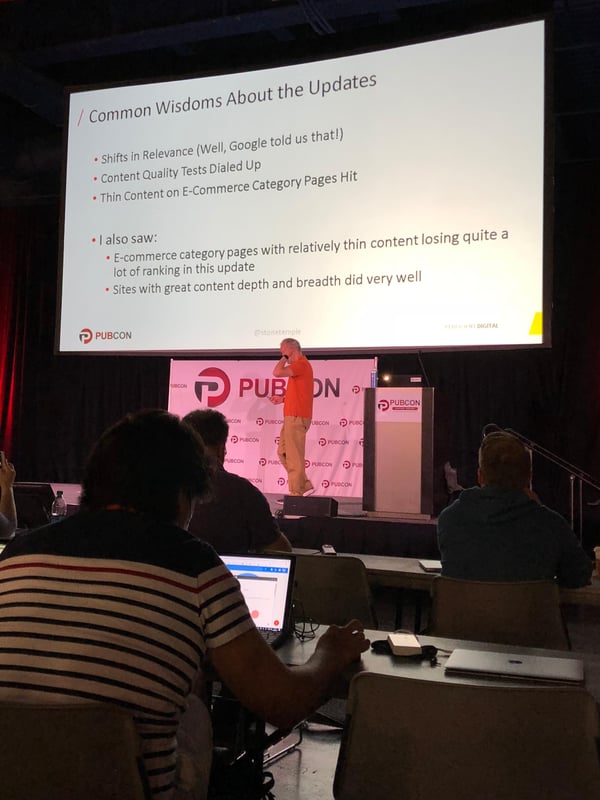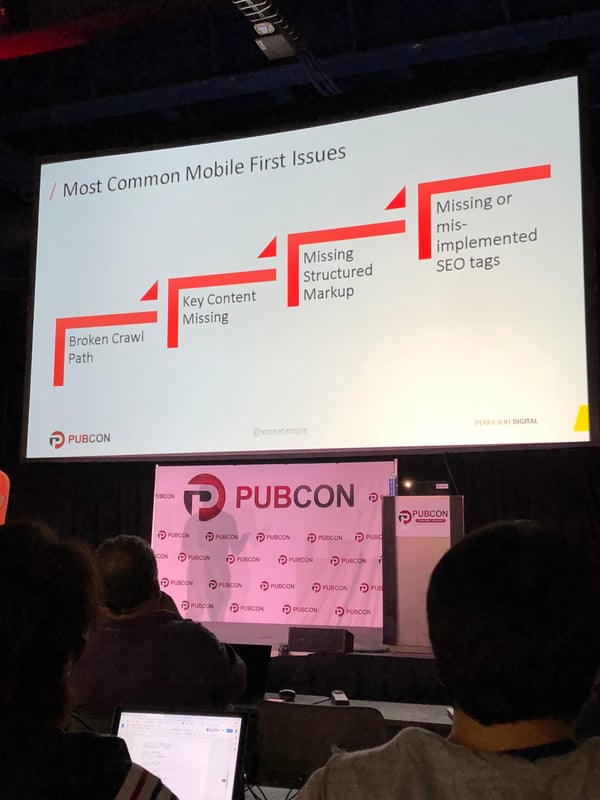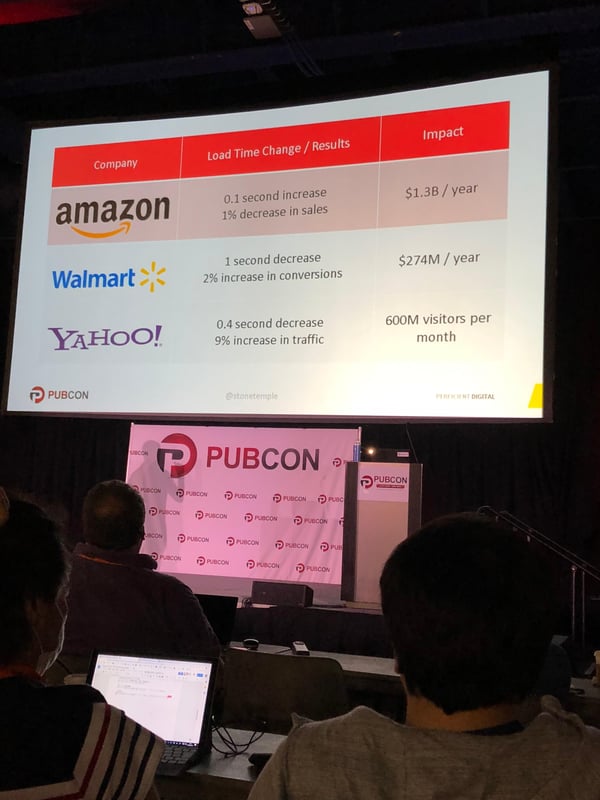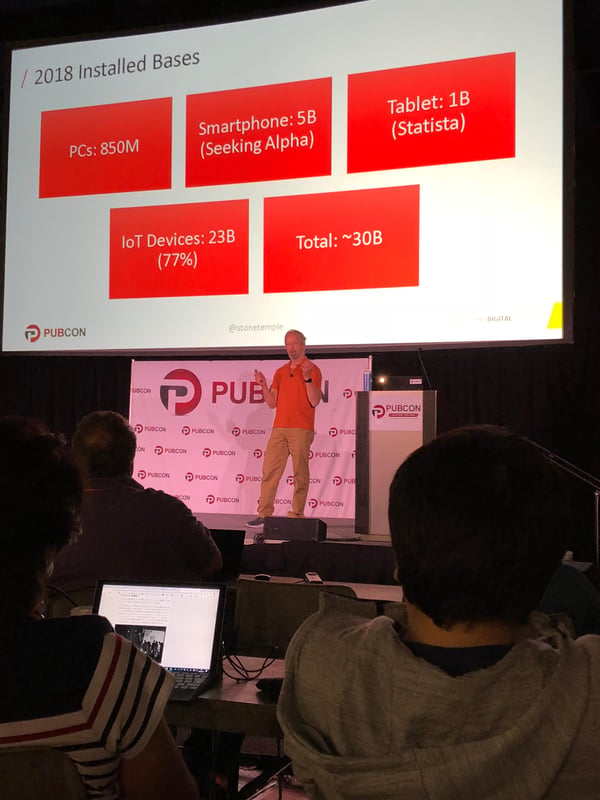Viva Las Vegas!
Last week I had the pleasure of attending PubCon 2018 with my colleague Nick Katseanes. We had a great time learning and networking at the show, and I only lost a modest amount of money on roulette.
PubCon featured an impressive speaker list and notable exhibitors, but what impressed me the most about this event was the commitment to maintaining and growing a community. The importance of community was echoed throughout the two-day conference and was supported by various networking-driven events.
If you were unable to attend PubCon in Vegas this year, you unfortunately missed out on some fantastic opportunities to connect with other marketers. However, I can help fill you in on some of the news and advice that was shared from the industry-leading voices at PubCon.
I wasn't able to attend all the sessions, so this is by no means a comprehensive recap, but I've picked out some of my favorites and covered them here. Enjoy!
What's new in Search? - Gary Illyes, Webmaster Trends Analyst, Google
PubCon '18 kicked off with a bang, featuring a keynote from Google Webmaster Trends Analyst, Gary Illyes.
Gary's keynote focused on helping SEOs understand the basics of optimization and how to help Google better understand your website.
On-Page Optimization
One of the first points Gary made was about how important good URLs are, and that you should avoid having hashtags in your URLs. According to Gary, JavaScript is the number one cause for hashtags appearing in URLs, so make sure you keep a close eye on your URLs if you're using JavaScript extensively.
Trend #1 for search via @methode: No hashtags in URLs. "If you have hashtags in URLs, I'm fairly certain that no search engine will know what to do with it." #Pubcon
— Tiffani Allen (@Tiffani_Allen) October 17, 2018
Gary also reiterated the importance of HTTPS and making your website secure, and mentioned that it's not difficult to switch to HTTPS these days. In regards to HTTPS as a ranking factor, Gary explained that it is used more as a tiebreaker.
From Gary @methode: there is a https rankings boost but it is more like a tiebreaker #pubcon
— Cass Downton (@cassdownton) October 17, 2018
Gary emphasized that metadata still matters, and promised there is no character limit for meta descriptions and that Google will just use enough to help people understand what your page is about. Gary also shared there are opportunities to win in search with images. His tips for image optimization included:
- Using alt-text, but with discretion.
- Adding captions to images.
- Lazy-loading images with <noscript>.
Already checking my lazy loading configuration to make sure that <noscript> is in use around image tags. Never thought about how crawlers see those. Good technical tip! @methode #Pubcon
— Lee Govatos (@govatos) October 17, 2018
Along with image optimization, Gary discussed the importance of website speed. He offered the following tips for optimizing your speed:
- Find a testing tool you like (Gary likes the Lighthouse Tool).
- Don't optimize for a single metric.
- Analyze how users react to your optimizations.
Gary also mentioned that interstitial popups can negatively impact your site.
If Google sees that interstitial on your page, be prepared to rank lower. @methode #pubcon
— Jennifer Slegg (@jenstar) October 17, 2018
Finally, Gary suggested using structured data to help Google better understand your pages, but advised using it reasonably and not stuffing structured data where it doesn't fit.
Mobile-First Indexing (MFI)
Gary also discussed mobile-first indexing and Google's plans for it in the future.
Many sites have already moved over to the mobile-first index, Gary explained, and they should have received a message in Google Search Console. Of course, more sites will be moving to MFI, and Gary mentioned that previously only mobile-friendly sites were being transitioned over, but moving forward that will change (even sites that aren't mobile-friendly will be moved to MFI).
So how do you know if your site is MFI ready? Fortunately, Gary shared some of the criteria for being MFI ready:
What’s does it mean to be mobile first index ready?
— Kevin Gibbons (@kevgibbo) October 17, 2018
- Content, video images
- Metadata, structured data
- Internal links
- Crawl capacity@methode #pubcon pic.twitter.com/mfJ7rUsxkJ
Gary also added that Google won't use the desktop version of a website in mobile-first indexing unless it's the only version available. He recommended using responsive design, but explained that any mobile-friendly options work fine for MFI. Gary also let us know that hamburger menus and fold-out content are fine on mobile.
Responsive = awesome
— Stasi Richmond (@stasi74) October 17, 2018
Google won’t use desktop site in MFI unless it’s the only version (and you will rank lower)
Hamburger menu = fine
Fold out content = fine - content hidden will get the full weight in ranking, it won’t change anything #PubCon #MobileFirstIndexing @methode
Finally, one last interesting nugget Gary shared was that unless you have millions of pages, you don't really need to worry about crawl budget.
It was an exhilarating start to the show to be able to hear directly from Google and Gary shared some helpful insight into how their search engine operates.
Meet the Future of Content Marketing: The Content Brand - Joe Pulizzi, Founder, Content Marketing Institute
Joe Pulizzi, Founder of Content Marketing Institute, presented on the future of content marketing — the content brand.
Joe launched his presentation with a story about George Lucas and the money he made with Star Wars merchandising, explaining that most content creators don't think big enough.
Joe encouraged us all to build our own content brand, which is a simple two-step process:
- Build a loyal audience.
- Monetize it.
While most marketers know how to build a loyal audience, the second step — monetizing content — can be a bit trickier. Fortunately, Joe shared The Content Inc model — a blueprint for monetizing content marketing.
The #content inc model from @JoePulizzi at #PubCon pic.twitter.com/xjBbaLKdEM
— Stasi Richmond (@stasi74) October 17, 2018
Identify Your Sweet Spot
The first place to start when trying to monetize content is with your "sweet spot."
Your content sweet spot is the intersection of your company's knowledge and skillset and your customers' passions and pain points.
Find your sweet spot @JoePulizzi #Pubcon pic.twitter.com/ZjHsJEHiyF
— Trish Carey (@TrishCarey) October 17, 2018
If you're in business, you should already have a solid idea of where your sweet spot lives.
Find the Content Tilt
Once you've honed in on your sweet spot, you need to find the content tilt.
Joe explained that nearly everyone can find the sweet spot, but then they stop there. Hardly anyone tilts the content and finds the area of differentiation that separates themselves from the pack.
As @JoePulizzi put it "Hardly anyone tilts the content". When creating #content make it different then everyone else's. #PubCon pic.twitter.com/Le6fQsK0qt
— Matthew Michell (@matthewmichell) October 17, 2018
To really tilt your content you need to create a content mission statement. According to Joe, you can craft a content mission statement by focusing on:
- A core target audience.
- What will be delivered.
- And the outcome for that audience.
.@JoePulizzi: You need to put together a content mission statement that you refer to before creating anything. It should be about ONE thing to ONE audience. #pubcon #contentmarketing pic.twitter.com/mQaNZzbzlZ
— Amanda Milligan (@millanda) October 17, 2018
A content mission statement will bring focus to your content creation.
Build a Base
The next step in Joe's Content Inc Model is to build a solid audience base.
To do this, Joe shared a simple formula:
Gotta love consistency @JoePulizzi #Pubcon pic.twitter.com/kq5yx6mOBf
— Erin Noelle Moriarty (@ernie_003) October 17, 2018
The key points here are focusing on a singular content type and platform, and then delivering content on a consistent basis.
Consistent delivery over a long period of time is the only proven way to build a loyal fan base for your content. Joe suggested that the average time before you start seeing results is 12-18 months.
Preach! “If you’re only willing to commit to content marketing for 6-9 months, you might as well go back to running ads to distract people.” @JoePulizzi #pubcon
— Lee Odden (@leeodden) October 17, 2018
Joe also emphasized the importance of building your audience on a channel you control or own, to avoid the potential of losing your audience due to outside changes.
Be careful about marketing on rented land. Using platforms like Facebook and Twitter is great, but you never know when things change. The killing of Google+ is a great example. Preach @JoePulizzi! #pubcon
— Hank Hoffmeier (@hankhoffmeier) October 17, 2018
Joe pointed to email as the best channel for building an audience base.
Harvesting Your Audience
Email is the best channel for harvesting your audience because we have the most control there, and it gives us an opportunity to speak directly to our people. Joe shared a "Yay-Boo" scale to demonstrate the value of email.
How much control do we have about our subscribers? 🧐Think twice what’s really your most important platform #Pubcon pic.twitter.com/ElcVJIRHYO
— Teresa Wolf (@Teresa__Wolf) October 17, 2018
However, maintaining and growing your email list requires that you have an amazing e-newsletter. You also need some sort of exchange of value for your audience, such as:
- Ebooks.
- Research Reports.
- Etc.
These are the things that keep your audience coming back for more.
Diversification
After you've built a strong, core audience on a single platform, you can then begin to diversify and expand to other channels. The key point here is to focus on one channel first — too many brands try to do everything at once and wind up failing at all channels.
First you need your “minimum viable audience”. Then once you have this and you’re great at one thing, you can begin to diversify #pubcon @JoePulizzi
— Cass Downton (@cassdownton) October 17, 2018
Monetization
Finally, Joe shared the last step of his Content Inc Model — monetization.
Brands often want to jump to this step first, but that doesn't work. Joe's main point here was to create value for your audience first, THEN you can begin to extract value (money).
Takeaways
Joe shared a ton of interesting tips and insight into building a content brand and monetizing content marketing. His model was straightforward, but clearly demonstrated all the work that goes into a successful content brand.
To recap, his key takeaways were:
Build your own content platform @JoePulizzi #pubcon pic.twitter.com/f7SFt8E62b
— Eli Schwartz (@5le) October 17, 2018
3 Ways to Get Lost in International SEO (And How to Find Success) - Aleyda Solis, Founder, Orainti
I was super excited to see Aleyda Solis present, as I have followed her for a long time on Twitter, but never had the opportunity to see her present in-person.
Aleyda did not disappoint as she shared a wealth of information about international SEO (a topic I've been wanting to learn more about).
First, Aleyda laid out the three most common challenges for internationalization on your website:
- Lack of resources to maintain your international web presence.
- Not being able to rank well with your chosen international web structure.
- Ranking in international search results with the wrong pages.
She then proceeded to walk through how to overcome each of these unique challenges.
Lack of Resources
Since you don't have unlimited resources (don't we all wish!), you need to prioritize which international markets you will target.
Aleyda advised starting by looking at which countries are already bringing you traffic.
Not sure which countries to target internationally? Go to @googleanalytics --> GEO --> Location and see which countries your current visitors are coming from. @aleyda #Pubcon
— Marie Haynes (@Marie_Haynes) October 17, 2018
Aleyda also discussed other ways to prioritize international markets, including:
- Identify which markets your competition is already profiting from.
- Verify which countries have the most traffic potential (based on your top keywords).
- Gauge the level of existing organic search competition in potential international markets — backlinks, TLDs, types of websites, etc.
- Analyze which markets align with your own multilingual and international operations capacity
Along with these factors, she pointed out we need to remember that internationalization should be about our organization's resources and priorities as well.
Aleyda also shared a cool new, free calculator she built that can help you calculate the ROI of international SEO.
Aleyda has an international SEO ROI calculator to help you decide whether it makes sense to target another country.https://t.co/MbRstl8MBb@aleyda #Pubcon
— Marie Haynes (@Marie_Haynes) October 17, 2018
Along with using Aleyda's awesome calculator, she also suggested starting with a small pilot project with your top categories or pages to test international SEO efficacy.
Using the Right Web Structure
The second challenge Aleyda covered was how web structure impacts international rankings.
I totally love your charts @aleyda. Finally something clear that helps when it comes to decisions. #PubCon pic.twitter.com/tZG8iP70hp
— Teresa Wolf (@Teresa__Wolf) October 17, 2018
Aleyda stressed the importance of assessing and selecting the best web structure for internationalization. To help with this process, she provided the following tips:
- Avoid using scripts or cookies to show international versions of the same URL.
- Don't use parameters for international web structure, particularly for countries.
- For country targeting, choose between CCTLDs, sub-directories with GTLDs, or sub-domains with GLTDs.
Aleyda expanded on this last tip, explaining that each option has pros and cons.
Great breakdown of the pros and cons for international site structure from @aleyda at #Pubcon for #internationalseo #organicsearch #seotips pic.twitter.com/PCGDVeycsl
— Colton Miller (@BigCSEO) October 17, 2018
Highlighting how difficult international SEO can be, Aleyda pointed out that even Google is making errors with internationalization.
Even Google's help docs are not doing things completely right for internationalization. Some of their pages use parameters for localization where cctlds, subdirectories/subdomains with GTLDS could be a better option. @aleyda #Pubcon
— Marie Haynes (@Marie_Haynes) October 17, 2018
Consistency is critical with internationalization, as inconsistencies in geotargeting can cause confusion and alienate your users.
Ranking the Wrong International Pages
Finally, Aleyda covered the common issue of ranking the wrong pages in international search.
To avoid this problem, it's critical to localize and geolocate each version of your site. Ranking the wrong pages can impact your site negatively in terms of user experience, click-through rate, and conversions. Aleyda also shared a handy tip for testing your geolocation — you can use VPNs to emulate any location to test your implementations.
Another important tip that Aleyda shared was to avoid automatic redirects based on IP location. These redirects can provide a bad user experience and actually hinder the crawlability of your international versions. Aleyda provided a better solution — suggesting the relevant version of your site, and letting users choose.
Best option is to show a banner recognizing, "Ah! I see you are in Spain. Do you want to see the version of our site for Spain?"
— Marie Haynes (@Marie_Haynes) October 17, 2018
Give users the option.@aleyda #Pubcon
To ensure the right page ranks you need to localize every aspect of your content, including:
- URLs.
- Title tags.
- Meta descriptions.
- Navigation.
- Etc.
It's easy to overlook small sections of your website and wind up with areas that aren't translated or are in different languages, which is a poor user experience.
Aleyda also stressed the importance of getting native support for your various international versions, even if they are in the same language. To demonstrate her point, Aleyda compared Americans calling a sport "soccer" while England (and essentially the rest of the world) call that same sport "football."
Haha @aleyda calling us Americans out for saying soccer instead of football #Pubcon
— Andrew Dennis (@AndrewDennis33) October 17, 2018
Aleyda advised using ISO 639-1 values for languages and ISO 3166-1 for countries to ensure you have the right codes.
Lastly, Aleyda discussed hreflang tags — their importance, and how easy it is to mess them up. These tags should be added to your HTML head or within your XML sitemaps, as well as HTTP headers.
To help with hreflang, Aleyda shared this free tool she created! She also mentioned HREFLangBuilder as another option for more complex environments.
Takeaways
Aleyda shared a ton of great information about international SEO and internationalization. The main takeaways revolved around these three challenges:
- Lack of resources to maintain your international web presence.
- Not being able to rank well with your chosen international web structure.
- Ranking in international search results with the wrong pages.
And their solutions:
- Prioritize your international markets.
- Assess and select the best web structure.
- Localize and geolocate each version of your site.
Technical SEO - Eric Enge, General Manager, Perficient Digital
Eric began his presentation by sharing a fresh, new batch of articles proclaiming the death of SEO. However, in reality this is thankfully not the case.
SEO isn’t dead yet! Spending over time is continuing to rise and 76% of search traffic is organic @stonetemple #Pubcon pic.twitter.com/R14b0R10kl
— Kevin Gibbons (@kevgibbo) October 18, 2018
Eric also pointed to the fact that people hate ads and increasingly use ad blockers as another reason SEO is doing just fine. In fact, Google itself is even conducting a war against excessive ads with their algorithmic updates.
Eric pointed to recent updates which focused on content quality and shifts in relevance.

SERPs Change as Intent Changes
Eric also discussed how searcher intent can influence SERPs and lead to changes in the rankings.
Eric shared an example around digital cameras and demonstrated how over time the search results changed. The results went from a mixture of review sites and ecommerce pages, to three ecommerce pages and a Wikipedia result, to finally 100% ecommerce pages.
This result reflects how Google was able to recognize that the intent behind the given query was transactional, and they should return pages where users can make a purchase.
Eric shared a key point here — with recent Google updates, he has noticed a shift from just covering the main keyword to covering the complete user need.
E-A-T: Expertise, Authoritativeness, and Trustworthiness
Eric also covered a "hot topic" in SEO currently — E-A-T.
E-A-T stands for expertise, authoritativeness, and trustworthiness and it became a popular topic in the SEO industry after an August Google update seemed to put increased emphasis on E-A-T when ranking websites.
Eric pointed out that health sites were thought to be the main target — leading to the creation of the "Medic update" moniker for this update — but since this perception has changed.
Many within the industry saw an increased focus on E-A-T for rankings, particularly with "Your Money, Your Life" (YMYL) sites in the healthcare and financial niches. However, Eric shared that his findings pointed to continued growth for sites with great content depth and breadth.
Observations from @stonetemple on sites that are winning;
— Kevin Gibbons (@kevgibbo) October 18, 2018
- Continued growth for sites with great content depth and breath
- Major e-commerce brands with thin category pages recovered #PubCon pic.twitter.com/Pl6Nn7i50B
Eric even dropped a (slight) SEO bombshell during his presentation:
@stonetemple @methode E-A-T is very much specific to YMYL sites! #Pubcon
— Callum Scott (@mrcallumscott) October 18, 2018
This was big news, as Eric got this information straight from Gary Illyes (of Google).
Future of Search
Eric wrapped up his presentation with some future-looking analysis of search and the devices people use to search.
First, he discussed mobile usage and Google's push towards a mobile-first index. Eric echoed that many sites (including his own Stone Temple) have received messages in Search Console that they've been moved to mobile-first index.
Eric also shared a helpful graph discussing the most common mobile first issues.

Of course, as search shifts towards mobile, speed becomes increasingly important. To help with speed you can implement accelerated mobile pages (AMP) on your site, which load much faster than traditional web pages. Eric shared some impressive stats highlighting how major brands have benefited from AMP.

Finally, Eric discussed voice search and the rise of voice technology. According to Eric, half of smartphone users engage with voice technology, and many of them use the feature regularly. Eric also pointed out that the public stigma associated with using voice search is declining rapidly, which is contributing to the growth of voice search.
Smart speakers have also taken off, as households with smart speakers in them has risen 49% in the last five months. To take advantage of this growing populartiy as a marketer, we can create Alexa skills or Google actions.
Create Google voice actions with Firebase real-time database @stonetemple #pubcon pic.twitter.com/uZPkClJwB9
— Kevin Gibbons (@kevgibbo) October 18, 2018
This is probably a good idea, considering Eric shared data which points to 23 billion installations of IoT devices in 2018.

These exciting changes in search mean unique challenges and opportunities are ahead for digital marketers.
Takeaways
Eric's presentation was one of my favorites, and he shared a ton of great information. My main takeaways were:
- Google is continuously testing and tweaking results to better match the full intent behind a query.
- E-A-T is very much specific to YMYL sites.
- Technology is driving big changes in search and will continue to do so, particularly in regards to mobile and voice search.
Thank You PubCon
So there you have it, my recap of my first trip to PubCon.
I learned a lot, connected with some great people, and even avoided the craps table! I hope to attend next year and make it to even more outstanding sessions.
If you're thinking about attending PubCon Florida in March, or Vegas next year I would highly recommend it — I had a blast! And if you're looking for more information on this year's event — since this is by no means a comprehensive list of the speakers — I suggest checking out SEMrush's excellent collection of takeaways here.

